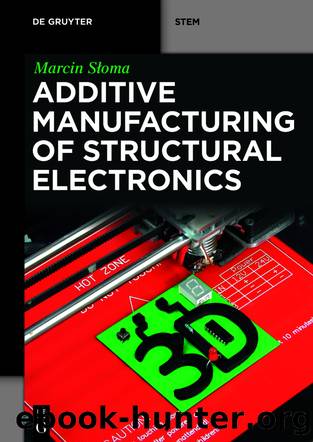Additive Manufacturing of Structural Electronics by Marcin Słoma

Author:Marcin Słoma
Language: eng
Format: epub
Publisher: De Gruyter
Published: 2024-06-18T13:59:40.908000+00:00
8.2
Core-shell nanomaterials
Electrically conductive nanoparticle inks, pastes and composites are dispersion of metallic nanoparticles, widely used as liquid medium inks for the fabrication of electrically conductive patterns in 3D printed electronics. While with nanomaterials, we observe an extensive agglomeration related to the strong van der Waals forces interaction between nanoparticles, causing poor dispersion or nozzle clogging, in most cases each metallic nanoparticle is encapsulated with organic additives to avoid agglomerations. The same organic additives, however, prevent contact between metallic nanoparticles limiting the electron transport and current flow therefore initially electrically nonconductive nanoparticle inks require sintering processes to decompose the organic additives. Organic additives are also to prevent the extensive reactivity of the nanoparticles, mainly oxidation and, therefore, are one of the key components of nanoparticle inks. Single-element metallic nanoparticles (Ag, Au, Cu) are widely used for formulating inks and pastes, with silver nanoparticles being highly preferred for fabricating conductive patterns due to the highest electrical conductivity from all metals and its excellent oxidation stability. Alternatively, gold nanoparticles also have good electrical conductivity and oxidation stability, but their price tag is much higher due to the cost of gold on the market. Therefore, the high interest is focused on copper inks, with the Cu cost much lower than silver and gold and comparable electrical conductivity with silver. However, copper nanoparticle inks as a substitute for expensive silver nanoparticle inks may not be so easy to implement, because copper nanoparticles are highly reactive under ambient atmosphere and tend to oxidize easily into copper oxides (semiconductors or dielectrics) during sintering at high temperature [690], [691]. Here, a new group of bimetallic core-shell nanoparticle inks emerges, still in the research phase, trying to step into the market. The core-shell nanoparticles comprise two different materials, where the outer shell is usually oxidation stable (Ag, Au, Ni) preventing the inner core (i.âe., Cu, Al) from oxidation and corrosion [692], [693]. Besides the limited environmental influence on the main core material, core-shell nanoparticles offer several advantages in achieving the desired electrical, optical or chemical by tuning the core-to-shell materials ratio. Also, the economic aspect plays here an important role, while it is easy to reduce the load of expensive materials. The copper-silver (CuNP@Ag) core-shell bimetallic nanoparticles are one example, where a thin silver shell protects the copper core from oxidation [692], [694]. These nanoparticles are gaining more traction in the fabrication of electronic inks and composites while the load of expensive silver is significantly reduced, retaining exceptional electrical properties [695]. Other core-shell bimetallic nanoparticle inks are also developed such as Ni-coated [696] or Sn-coated [697].
Download
This site does not store any files on its server. We only index and link to content provided by other sites. Please contact the content providers to delete copyright contents if any and email us, we'll remove relevant links or contents immediately.
Whiskies Galore by Ian Buxton(41938)
Introduction to Aircraft Design (Cambridge Aerospace Series) by John P. Fielding(33092)
Small Unmanned Fixed-wing Aircraft Design by Andrew J. Keane Andras Sobester James P. Scanlan & András Sóbester & James P. Scanlan(32764)
Aircraft Design of WWII: A Sketchbook by Lockheed Aircraft Corporation(32248)
Craft Beer for the Homebrewer by Michael Agnew(18197)
Turbulence by E. J. Noyes(7978)
The Complete Stick Figure Physics Tutorials by Allen Sarah(7338)
The Institute by Stephen King(6988)
Kaplan MCAT General Chemistry Review by Kaplan(6900)
The Thirst by Nesbo Jo(6877)
Bad Blood by John Carreyrou(6583)
Modelling of Convective Heat and Mass Transfer in Rotating Flows by Igor V. Shevchuk(6406)
Learning SQL by Alan Beaulieu(6237)
Weapons of Math Destruction by Cathy O'Neil(6215)
Man-made Catastrophes and Risk Information Concealment by Dmitry Chernov & Didier Sornette(5956)
Permanent Record by Edward Snowden(5796)
Digital Minimalism by Cal Newport;(5704)
Life 3.0: Being Human in the Age of Artificial Intelligence by Tegmark Max(5516)
iGen by Jean M. Twenge(5385)
